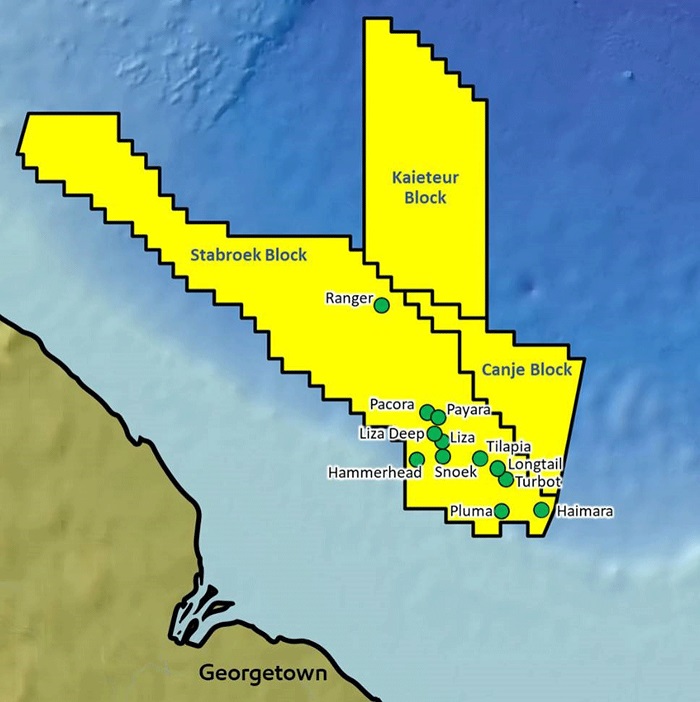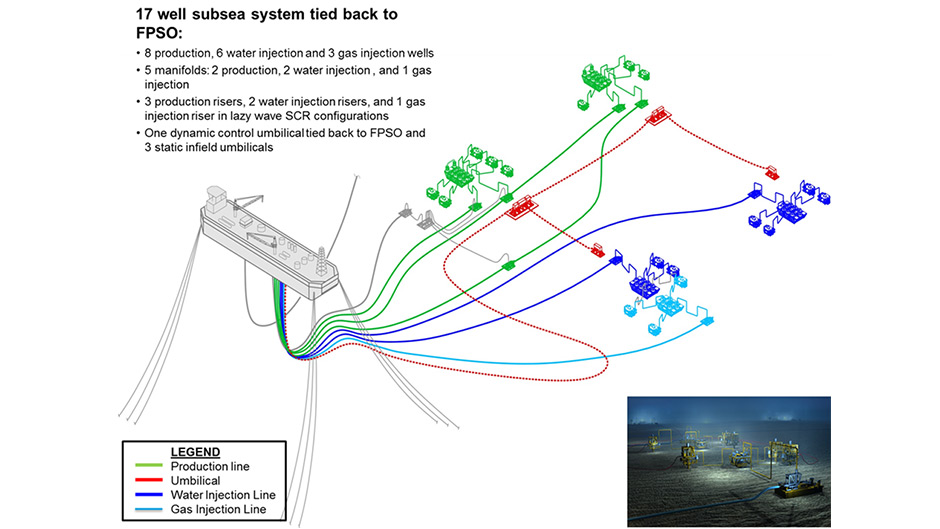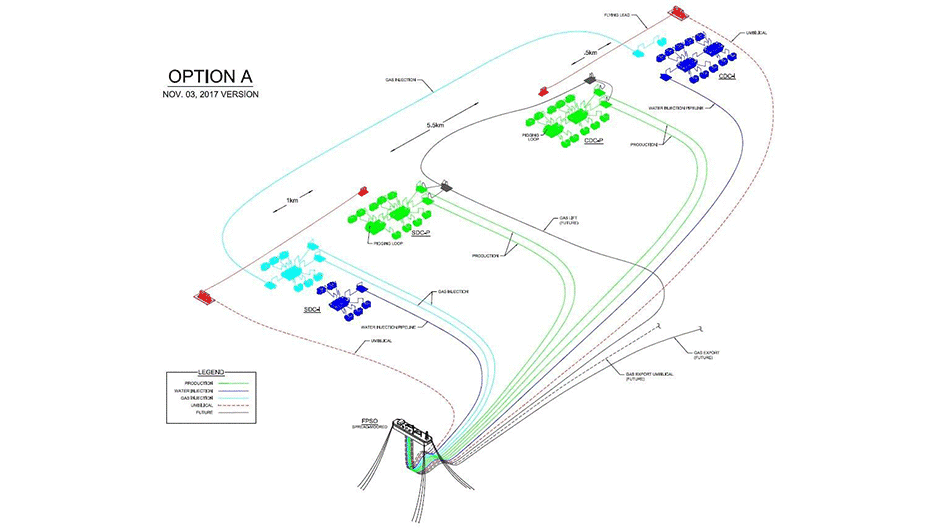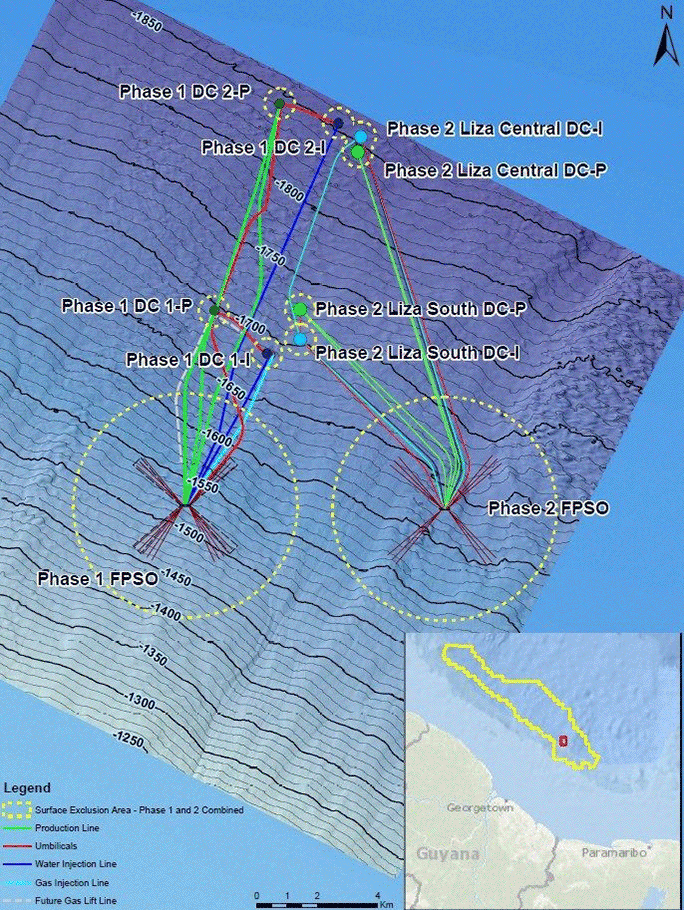(Exxon, 14.Feb.2019) — ExxonMobil initiated oil and gas exploration activities in Guyana in 2008, collecting and evaluating substantial 3-D seismic data that led to the company safely drilling its first exploration well in 2015, Liza-1.
Drilling activity in the Stabroek Block
— Liza-1 well discovery was announced in May 2015
— Liza-2 well was drilled and tested in July 2016
— Liza-3 well was drilled in October 2016, confirming a world-class resource discovery in excess of 1 billion oil-equivalent barrels
— Liza-4 well was drilled in March 2017 and encountered more than 197 feet of high-quality, oil-bearing sandstone reservoirs, which will underpin a potential Liza Phase 2 development
— Appraisal drilling at Liza 3 identified an additional high quality deeper reservoir directly below the Liza field, which is estimated to contain resources between 100 and 150 million oil-equivalent barrels
— Skipjack-1 was drilled in September 2016; this did not encounter commercial quantities of hydrocarbons
— Payara-1 well discovery was announced in January 2017. Payara is ExxonMobil’s second oil discovery on the Stabroek Block and was drilled in a new reservoir — encountering more than 95 feet of high quality, oil bearing sandstone reservoirs
— Payara-2 well discovery was announced in July 2017. Payara-2 encountered 59 feet (18 meters) of high-quality, oil-bearing sandstone reservoirs
— Snoek-1 well discovery was announced in March 2017. Snoek is ExxonMobil’s third oil discovery on the Stabroek Block and was drilled in a new reservoir — encountering 82 feet (25 meters) of high-quality, oil-bearing sandstone reservoir
— Turbot-1 well discovery was announced in October 2017. Turbot is ExxonMobil’s fifth oil discovery on the Stabroek Block and was drilled in a new reservoir — encountering approximately 75 feet (23 meters) of high-quality, oil-bearing sandstone reservoir
Ranger-1 well discovery was announced in January 2018. Ranger is ExxonMobil’s sixth oil discovery on the Stabroek Block and was drilled in a new reservoir- encountering approximately 230 feet (70 meters) of high-quality, oil-bearing carbonate reservoir
— Pacora-1 well discovery was announced in February 2018. Pacora is ExxonMobil’s seventh oil discovery on the Stabroek Block and was drilled in a new reservoir — encountering approximately 65 feet (20 meters) of high-quality, oil-bearing sandstone reservoir
— Sorubim-1
was drilled in April 2018; this did not encounter commercial quantities of
hydrocarbons
– Longtail-1 well discovery was announced in June 2018. Longtail is
ExxonMobil’s eighth oil discovery on the Stabroek Block and was drilled in a
new reservoir — encountering approximately 256 feet (78 meters) of
high-quality, oil-bearing sandstone reservoir
— Hammerhead-1 well discovery was announced in August 2018. Hammerhead is ExxonMobil’s ninth oil discovery on the Stabroek Block and was drilled in a new reservoir — encountering approximately 197 feet (60 meters) of high-quality, oil-bearing sandstone reservoir
— Pluma-1 well discovery was announced December 2018. Pluma is ExxonMobil’s tenth on the Stabroek Block and was drilled in a new reservoir — encountering approximately 121 feet (37 meters) of high-quality hydrocarbon-bearing sandstone reservoir
— Tilapia-1 well was announced in January 2019. Tilapia-1 encountered approximately 305 feet (93 meters) of high-quality oil-bearing sandstone reservoir
— Haimara-1 well discovery was announced in January 2019. Haimara-1 encountered approximately 207 feet (63 meters) of high-quality, gas-condensate bearing sandstone reservoir
— The gross recoverable resource for the Stabroek Block is now estimated to total more than 5 billion oil equivalent barrels, including Liza and other successful exploration wells on Payara, Liza deep, Snoek, Turbot, Ranger, Pacora, Longtail and Hammerhead

Liza Phase 1 project – Development description
— The Liza Phase 1 development is approximately 190 kilometers offshore in water depths of 1,500 – 1,900 meters
— The development plan includes completion of a floating production, storage and offloading (FPSO) vessel designed to produce up to 120,000 barrels of oil per day
— Four drill centers are envisioned with 17 wells in total; eight production wells, six water injection wells, and three gas injection wells

Liza Phase 2 – Development description
The development plan involves a second floating, production, storage and offloading vessel (FPSO) and related subsea equipment, umbilical, risers and flowlines.
The development concept is similar to that of Liza phase 1. Approximately 35-40 wells may be drilled at two subsea drill centers which will consist of a combination of producers and injectors to support production of oil, injection of water, and reinjection of associated gas.
The FPSO will have an estimated production capacity of approximately 190,000 to 220,000 barrels of oil per day.


***